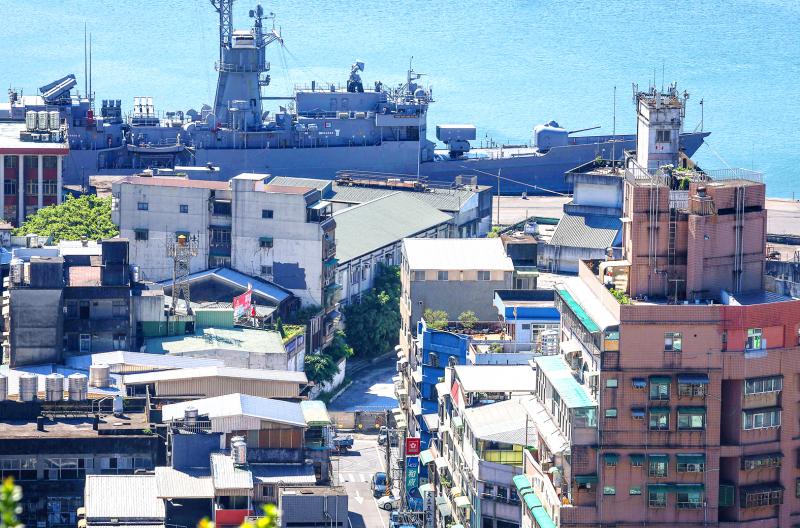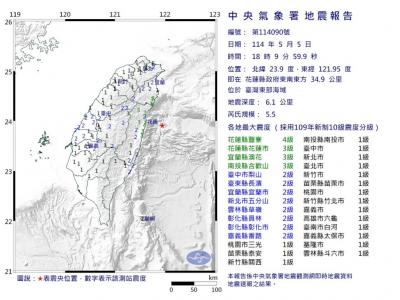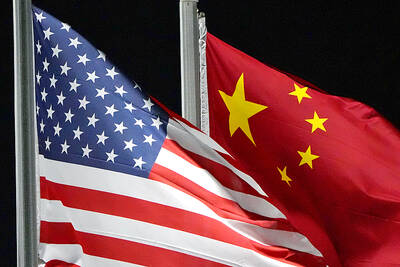Beijing’s largest-ever exercises around Taiwan have offered essential clues into its plans for a grueling blockade in the event of an attack on Taiwan, and revealed an increasingly emboldened Chinese military, experts said.
The visit to Taiwan by US House of Representatives Speaker Nancy Pelosi — second in line to the presidency — sparked outrage from Beijing, which launched vast military maneuvers around the nation, even at the risk of partially exposing its plans to the US and its Asian allies.
Mobilizing fighter planes, helicopters and warships, the drills aim to simulate a blockade of Taiwan and include practicing an “attack on targets at sea,” Chinese state news agency Xinhua said.

Photo: CNA
It is the first time Chinese exercises have taken place so close to Taiwan, with some of the drills happening less than 20km from the coast.
Also unprecedented are Beijing’s drills on Taiwan’s eastern flank, a strategically vital area for supplies to Taiwan’s military, as well as any potential US reinforcements.
A “blockade scenario” was long speculated to be one of China’s preferred strategies were it to try to conquer Taiwan, and this week’s drills have revealed how that might occur.
Such a siege would aim to prevent any entry or exit of commercial or military ships and aircraft. It would also deny US forces stationed in the region access to Taiwan.
The Chinese military “obviously has all the capabilities to impose such a blockade,” independent Chinese military analyst Song Zhongping (宋忠平) said.
The Chinese military fired a dozen ballistic missiles on Thursday that hit various areas around Taiwan, with some flying over Taipei, Beijing’s state broadcaster CCTV said on Friday.
Xinhua said that Beijing has mobilized more than 100 planes, and more than 10 frigates and destroyers, including the J-20 stealth fighter and a Type 055 destroyer, the crown jewels of China’s air and naval forces.
The exercises also make it possible to test and sharpen the level of coordination between the mobilized army corps — land, sea, air and rocket forces, as well as strategic support, tasked with cyberwarfare.
It is also a crucial test for the recently inaugurated Eastern Theater of Operations of the Chinese army, created in 2016, and which oversees the country’s entire eastern maritime space, in which Beijing includes Taiwan.
What China has done so far demonstrates its “robust capabilities,” Australian National University international security professor John Blaxland said.
“They can’t be dismissed as some kind of less inexperienced, incapable force,” he said. “They clearly have the ability to coordinate their land and sea, they have the ability to deploy missile systems, and they function effectively.”
“The converse, of course to this is that what they are doing is being closely studied and monitored for lessons to be learned by Taiwan, the United States, Japan and others,” Blaxland said.
During the Taiwan Strait crisis of 1995 and 1996, the US Navy transited several warships through the waterway and deployed aircraft carriers near the nation.
This time, however, “the US government is taking prudent steps to avoid unwanted escalation,” said Lonnie Henley, a former US intelligence officer and professor at the Elliott School of International Studies in Washington.
Caution is also rooted in the fact that China has greatly increased its military capabilities since 1996, when it was unable to deny the US Navy access to the area, he said.
“In some areas, the PLA [Chinese People’s Liberation Army] might even surpass US capabilities,” said Grant Newsham, a former US Navy officer and researcher at the Japan Forum for Strategic Studies.
“If the battle is confined to the area right around Taiwan, today’s Chinese navy is a dangerous opponent, and if the Americans and Japanese do not intervene for some reason, things would be difficult for Taiwan,” he said.
Chinese incursions across the so-called median line between Taiwan and China — never recognized by Beijing — also speak to a growing confidence, experts said.
“China has not felt comfortable to push its claims on the median line until recently,” Blaxland said. “We can expect them to continue to operate as if the median line is not valid. That’s been the case for a while, but it’s now accelerating.”

An essay competition jointly organized by a local writing society and a publisher affiliated with the Chinese Communist Party (CCP) might have contravened the Act Governing Relations Between the People of the Taiwan Area and the Mainland Area (臺灣地區與大陸地區人民關係條例), the Mainland Affairs Council (MAC) said on Thursday. “In this case, the partner organization is clearly an agency under the CCP’s Fujian Provincial Committee,” MAC Deputy Minister and spokesperson Liang Wen-chieh (梁文傑) said at a news briefing in Taipei. “It also involves bringing Taiwanese students to China with all-expenses-paid arrangements to attend award ceremonies and camps,” Liang said. Those two “characteristics” are typically sufficient

A magnitude 5.9 earthquake that struck about 33km off the coast of Hualien City was the "main shock" in a series of quakes in the area, with aftershocks expected over the next three days, the Central Weather Administration (CWA) said yesterday. Prior to the magnitude 5.9 quake shaking most of Taiwan at 6:53pm yesterday, six other earthquakes stronger than a magnitude of 4, starting with a magnitude 5.5 quake at 6:09pm, occurred in the area. CWA Seismological Center Director Wu Chien-fu (吳健富) confirmed that the quakes were all part of the same series and that the magnitude 5.5 temblor was

The brilliant blue waters, thick foliage and bucolic atmosphere on this seemingly idyllic archipelago deep in the Pacific Ocean belie the key role it now plays in a titanic geopolitical struggle. Palau is again on the front line as China, and the US and its allies prepare their forces in an intensifying contest for control over the Asia-Pacific region. The democratic nation of just 17,000 people hosts US-controlled airstrips and soon-to-be-completed radar installations that the US military describes as “critical” to monitoring vast swathes of water and airspace. It is also a key piece of the second island chain, a string of

The Central Weather Administration has issued a heat alert for southeastern Taiwan, warning of temperatures as high as 36°C today, while alerting some coastal areas of strong winds later in the day. Kaohsiung’s Neimen District (內門) and Pingtung County’s Neipu Township (內埔) are under an orange heat alert, which warns of temperatures as high as 36°C for three consecutive days, the CWA said, citing southwest winds. The heat would also extend to Tainan’s Nansi (楠西) and Yujing (玉井) districts, as well as Pingtung’s Gaoshu (高樹), Yanpu (鹽埔) and Majia (瑪家) townships, it said, forecasting highs of up to 36°C in those areas